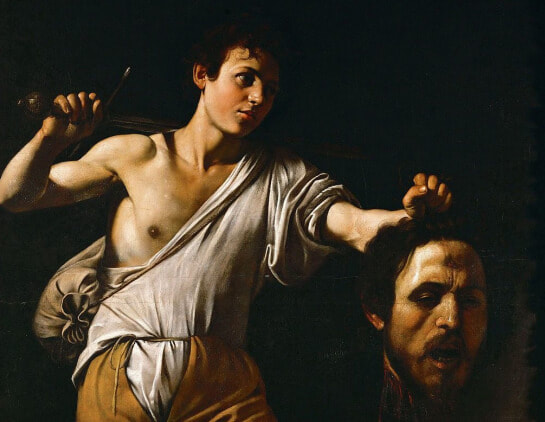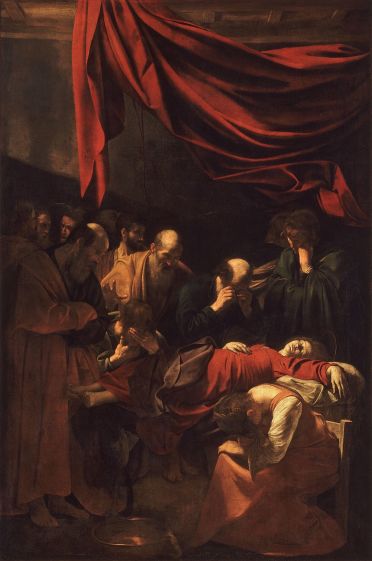|
Where? Room 6 of the Prado Museum
When? Around 1600 Commissioned by? Unknown What do you see? David is tying the hair of Goliath with a rope after he beheaded him. This would allow him to carry the head with him and show it as proof that he killed Goliath. David wears a white fabric that he tucked into his beige pants. He bends down with his left knee on top of the shoulders of the beheaded body of Goliath. David is concentrated on his task and does not show any sign of triumph. It seems a serious and necessary task that he is completing. On the left, we can see the large right hand of the giant. Goliath has thick curly hair and a black beard. We can also see the wound on his forehead where the stone from David’s sling hit him. Caravaggio created a strong contrast between light and dark to emphasize the important body parts in this painting. The right leg, back, and arms of David are in the light, as are the head, shoulders, and right hand of Goliath. Backstory: The exact date that Caravaggio painted this work is unclear, but experts believe that he created this between 1596 and 1600. The painting was taken to Spain after Caravaggio completed it. There, it had a big impact on the Spanish artists of that time. This painting is based on the Biblical story of David and Goliath in 1 Samuel 17. However, this story does not mention that David used a rope to tie the hair of Goliath. This is just a free interpretation of the Biblical story by Caravaggio. Other versions by Caravaggio: Caravaggio painted David with the Head of Goliath a total of three times at different stages of his career. In 1607, he painted his second version, which is on display in the Kunsthistorisches Museum in Vienna. In this version, David grabs the hair of Goliath to hold his head in his hand. The third version from 1610 is in the Galleria Borghese in Rome. The second and third versions are quite similar. The main differences are the age of the head of Goliath and the way in which David holds his sword.
David and Goliath: 1 Samuel 17 describes the story of David and Goliath. Israel was at war with the Philistines. The Philistines had a hero called Goliath who was over 9 feet (2.75 meters) tall. Goliath proposed every day to the Israelites that instead of letting the armies fight each other, they should send one man to fight him. If Goliath would win the fight, the Israelites would become slaves of the Philistines, and if Goliath would lose, the Philistines would become slaves of the Israelites.
David convinced King Saul that he should fight Goliath. He went out of the army camp to meet Goliath, wearing no armor but bringing a walking stick, a sling, and a bag with five smooth stones. He put a stone in his sling and threw it at Goliath, hitting him between his eyes. Goliath fell, and David took Goliath’s sword to kill him by cutting off his head. He took the head of Goliath back to Jerusalem but kept his sword and spear for himself. Who is Caravaggio? Michelangelo Merisi da Caravaggio (1571-1610) was born in Caravaggio near Milan, Italy. In 1592, he fled to Rome to escape a conviction in Milan. Around 1600, he became very popular and was probably the most sought-after painter in Rome. He received the most prestigious commissions, and many people enjoyed the contrasts, drama, and emotions he included in his works. In the years after he painted the first version of David with the Head of Goliath, Caravaggio painted several other masterpieces, including The Entombment of Christ between 1602 and 1604 in the Vatican Museums and Death of the Virgin between 1601 and 1606 in the Louvre.
Fun fact: X-ray analysis revealed that Caravaggio initially wanted to paint a much more expressive version of Goliath. Underneath the canvas are traces of another design of the head of Goliath. In that design, Goliath has a much more terrifying expression on his face and his eyes almost pop out of his head. This version was more like the painting of Medusa of which Caravaggio painted two versions. The first version from 1596 is in a private collection and the second version, from 1597, is in the Uffizi Museum. However, the unknown commissioner of David with the Head of Goliath in the Prado Museum probably rejected this initial design after which Caravaggio settled on a more conservative version of Goliath’s head.
Written by Eelco Kappe
References:
0 Comments
Leave a Reply. |
Categories
All
|
- Home
- Blog
-
Museums
- Alte Pinakothek
- Art Institute of Chicago
- Baltimore Museum of Art
- Barber Institute of Fine Arts
- Bargello
- Barnes Foundation
- British Museum
- Church of Sant’Anastasia
- Cleveland Museum of Art
- Courtauld Institute of Art
- Detroit Institute of Arts
- Frans Hals Museum
- Galleria Borghese
- Gallerie dell'Accademia
- Getty Museum
- Guggenheim
- Hermitage Museum
- Kunsthistorisches Museum
- Kunstmuseum Basel
- Legion of Honor Museum
- Louvre
- Mauritshuis
- Metropolitan Museum of Art
- Musee d’Orsay
- Museum of Fine Arts in Boston
- Museum of Modern Art
- National Gallery in London
- National Gallery of Art
- National Museum in Poznań
- Norton Simon Museum
- Ny Carlsberg Glyptotek
- Palace of Versailles
- Palazzo Pitti
- Palazzo Vecchio
- Petit Palais
- Philadelphia Museum of Art
- Prado
- Pushkin Museum
- Ravenna Art Museum
- Rijksmuseum
- San Diego Museum of Art
- Santa Maria delle Grazie
- St. Peter's Basilica
- Städel Museum
- Statens Museum for Kunst
- Tate Britain
- Tate Modern
- Timken Museum of Art
- Uffizi
- Vatican Museums
- Wallace Collection
-
Artists
- Altdorfer
- Anguissola
- Berlin Painter
- Bosch
- Botticelli
- Boucher
- Bronzino
- Bruegel the Elder
- Brunelleschi
- Cabanel
- Caillebotte
- Canova
- Caravaggio
- Carpeaux
- Cezanne
- Cimabue
- David
- Degas
- Delacroix
- De Maria
- Donatello
- El Greco
- Fontana
- Fra Angelico
- Fragonard
- Gauguin
- Gentileschi
- Gericault
- Gonzalez-Torres
- Goya
- Hals
- Hogarth
- Hokusai
- Ingres
- Leonardo da Vinci
- Lippi, Filippo
- Longhi, Barbara
- Lorrain
- Makovsky
- Manet
- Massys
- Matisse
- Merian
- Michelangelo
- Mochi
- Modigliani
- Monet
- Panini
- Parmigianino
- Perugino
- Picasso
- Pisanello
- Raphael
- Rembrandt
- Renoir
- Reynolds
- Rivera
- Rodin
- Rubens
- Scultori
- Seurat
- Steen
- Tintoretto
- Titian
- Toulouse-Lautrec
- Turner
- Uccello
- Van der Weyden
- Van Dyck
- Van Eyck
- Van Gogh
- Van Hemessen
- Vasari
- Velazquez
- Vermeer
- Veronese
- Vigée Le Brun
-
Locations
- Books
- About Us






